Biamp Legend Bimix...20/16 Mixer...($60.00 Craigslist including the power supply)
I know I know, it's starting to become apparent i have an old console fetish, but this one sorta took me by surprise...
The Amerimex sounded good when I could get it to cooperate, but it was a bit finicky and I still need to get a power supply that can manage the demands...
So this Biamp is a bit of a sleeper...the only issue with this board was the communications channel and I found a guy that sold me an OEM unit for $20.00...
Now I know Baimp does not really register in the "studio quality" of pursuable consoles but this one seems to be quite versatile and after going through the unit, the schematics and a listening test I am quite impressed.
This is a "2016" which means it is 20 channels in with 16 buses...yep 16 different bus channels available on every channel, they do this by using an opamp for the buffer as the pan control (to eliminate crosstalk)
Each channel has direct out, as well as a different sub out with its own volume control as well as the option to bus it to any/all of the 16 channels...channels 17/18 19/20 function as EFX or Cue channels for separate headphone mixes but it also has a control room output as well... its the most flexible board this size I have ever seen...which makes it perfect for a small studio environment...
I did some A/B testing to compare the discrete channel preamps with my Apogee preamps and basically they sound just as good but not as loud.
While it is a bit dated (lots of "tape input"stuff) it does provide some nice options because you can set up each channel to function as a direct Mic/Line in or with the push of a switch it goes to the tape input...
It is incredibly quiet, which kinda surprised me...the only thing that gets loud is when you turn on the power supplies "48v" to power the board for phantom...the transformer for that part of the psu hums...the rest of the psu is passive cooled (and the 48v is a "soft delay" on the console...but even that is not that load I'm just a freak about noise because I'm in a smaller space...
Pretty happy with this purchase,,,saw in craigslist and researched it, found the schematic and figured it'd be worth $60 just to see how they pulled off the discrete section...
But now I have three consoles in a room not that big...I can see though that the Soundcraft and Amerimex will on get turned on for rare conditions...if ever.
I know I know, it's starting to become apparent i have an old console fetish, but this one sorta took me by surprise...
The Amerimex sounded good when I could get it to cooperate, but it was a bit finicky and I still need to get a power supply that can manage the demands...
So this Biamp is a bit of a sleeper...the only issue with this board was the communications channel and I found a guy that sold me an OEM unit for $20.00...
Now I know Baimp does not really register in the "studio quality" of pursuable consoles but this one seems to be quite versatile and after going through the unit, the schematics and a listening test I am quite impressed.
This is a "2016" which means it is 20 channels in with 16 buses...yep 16 different bus channels available on every channel, they do this by using an opamp for the buffer as the pan control (to eliminate crosstalk)
Each channel has direct out, as well as a different sub out with its own volume control as well as the option to bus it to any/all of the 16 channels...channels 17/18 19/20 function as EFX or Cue channels for separate headphone mixes but it also has a control room output as well... its the most flexible board this size I have ever seen...which makes it perfect for a small studio environment...
I did some A/B testing to compare the discrete channel preamps with my Apogee preamps and basically they sound just as good but not as loud.
While it is a bit dated (lots of "tape input"stuff) it does provide some nice options because you can set up each channel to function as a direct Mic/Line in or with the push of a switch it goes to the tape input...
It is incredibly quiet, which kinda surprised me...the only thing that gets loud is when you turn on the power supplies "48v" to power the board for phantom...the transformer for that part of the psu hums...the rest of the psu is passive cooled (and the 48v is a "soft delay" on the console...but even that is not that load I'm just a freak about noise because I'm in a smaller space...
Pretty happy with this purchase,,,saw in craigslist and researched it, found the schematic and figured it'd be worth $60 just to see how they pulled off the discrete section...
But now I have three consoles in a room not that big...I can see though that the Soundcraft and Amerimex will on get turned on for rare conditions...if ever.















![Electronics Soldering Iron Kit, [Upgraded] Soldering Iron 110V 90W LCD Digital Portable Soldering Kit 180-480℃(356-896℉), Welding Tool with ON/OFF Switch, Auto-sleep, Thermostatic Design](https://m.media-amazon.com/images/I/41gRDnlyfJS._SL500_.jpg)



















